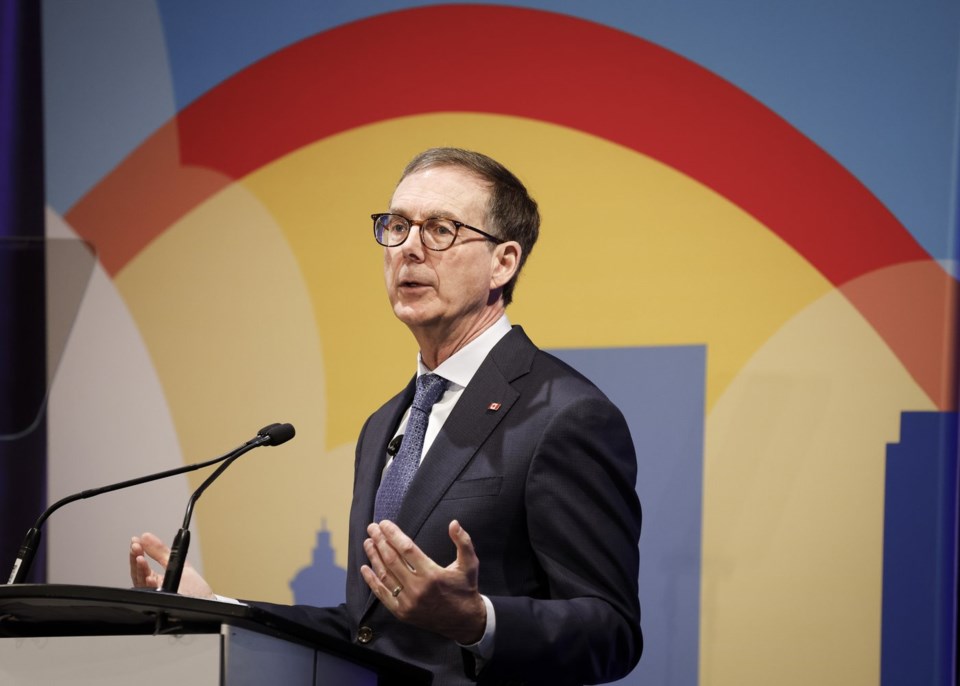OTTAWA — The Bank of Canada’s top decision makers signalled they likely would have puased the interest rate easing cycle earlier this month if not for the substantial uncertainty around tariffs from the United States.
That’s according to the central bank’s summary of deliberations released Wednesday, which offers a look at how governing council arrived at its March 12 decision to cut the policy rate by a quarter-point to 2.75 per cent.
Those high-level discussions paint a picture of the Bank of Canada governors attempting to set monetary policy during a complex and fluid situation.
The rate decision came a little over a week after the U.S. levied its first round of blanket tariffs on Canadian goods entering the country and the same day Canada’s largest trading partner launched a new wave of tariffs targeting steel and aluminum imports.
Those trade restrictions have been scaled back or adjusted multiple times already, with additional deadlines for new tariffs looming in the days to come. The White House said Wednesday afternoon that U.S. President Donald Trump would announce tariffs on auto imports later in the day, and other measures are slated to take affect on April 2.
The Bank of Canada’s governing council noted the Canadian economy had been performing above expectations heading into 2025, which could have provided conditions for a rate hold after six consecutive cuts.
But the council noted that tariff threats had already “sharply” weakened business and consumer confidence. Price hikes were also expected to follow from the trade dispute, though how quickly those costs would be passed along remained an open question.
New data around tariffs had “shifted the balance” for monetary policymakers, the deliberations said, with less risk now that inflation would drop too far below the central bank’s two per cent target.
The Bank of Canada’s top decisionmakers ultimately agreed that, “in the absence of tariff threats and elevated uncertainty, the decision would probably have been to maintain the policy interest rate at three per cent.”
Some members of the governing council suggested that a rate hold could “still be appropriate” until there was more clarity on how and when the trade dispute would impact the Canadian economy.
Others argued that the threats of tariffs and accompanying uncertainty had already affected forecasts enough to warrant another cut.
A “clearly weakening” outlook and signs that inflation was still well contained tipped the scales for the governing council toward the quarter-point cut.
“This would provide some help to Canadians to manage the uncertainty related to tariffs,” the deliberations read.
Bank of Canada governor Tiff Macklem signalled in a speech on March 20 that the central bank would change up how it makes interest rate decisions amid higher-than-usual levels of uncertainty.
Macklem said monetary policymakers are going to shift their focus more toward setting a benchmark interest rate that’s better suited for the range of risks facing Canada, instead of what the central bank thinks is the most likely path forward for the economy.
The Bank of Canada’s next rate decision is set for April 16. The central bank is also that day scheduled to release a new monetary policy report sharing its outlook for the economy, but Macklem has cautioned those forecasts might not include a central economic projection for the coming quarters as it usually would.
The deliberations show members of the governing council agreed that because the situation was fluid and the shock to the economy would be complex, providing guidance on the future path for the policy rate “would not be appropriate.”
“Governing council agreed to proceed carefully with further changes to monetary policy,” the summary concluded.
Benjamin Reitzes, BMO's managing director of Canadian rates and macro strategist, said in a note to clients on Wednesday that the deliberations strike a "hawkish" tone — tilted toward keeping interest rates higher rather than lower.
The impact of tariffs on inflation is tough to discern, as they can both cause a spike in prices and drag down the economy, tempering spending demand.
Reitzes noted the Bank of Canada stressed in the deliberations that its mission was to not let initial uptick in prices spread and lead to generalized inflation. He added that February's inflation report, which saw inflation jump to 2.6 per cent amid the end of Ottawa's temporary tax holiday, "has surely gotten the BoC's attention and will only reinforce its hawkish bias."
Reitzes said further rate cuts aren't off the table if the tariff situation worsens, but the central bank's bias towards keeping inflation under control will limit how low the policy rate could go to provide relief in the trade war.
This report by The Canadian Press was first published March 26, 2025.
Craig Lord, The Canadian Press




